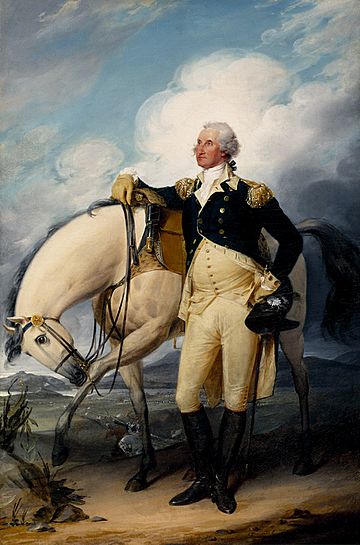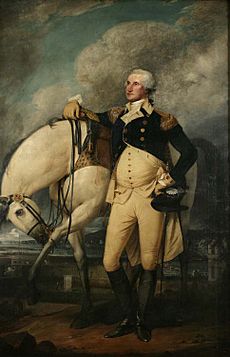Washington at Verplanck's Point facts for kids
Quick facts for kids Washington at Verplanck's Point |
|
|---|---|
 |
|
| Artist | John Trumbull |
| Year | 1790 |
| Medium | oil on canvas |
| Dimensions | 76.5 cm × 51.1 cm (30 1/8 in × 20 1/8 in) |
| Location | Winterthur Museum, Garden and Library, Winterthur, Delaware |
Washington at Verplanck's Point is a famous painting from 1790. It was created by the American artist John Trumbull. The painting shows General George Washington during the American Revolutionary War. He is standing at a place called Verplanck's Point on the North River in New York.
The background of the painting shows a special event. On September 14, 1782, Washington held a review of his Continental Army troops there. This was to honor the French commander, Comte de Rochambeau, and his army as they were leaving.
John Trumbull gave this painting as a gift to Washington's wife, Martha Washington. Today, the painting is kept at the Winterthur Museum. Later, the City of New York asked Trumbull to paint a much larger version. This new painting, called George Washington, has a different background. It shows Evacuation Day in New York City on November 25, 1783. This was when Washington returned and British forces left. You can see this larger painting at New York City Hall.
Contents
What the Painting Shows
General George Washington is dressed in his full military uniform. He wears a blue coat over a light brown (buff) waistcoat and pants. He stands in front of his white horse, named Blueskin. Washington is leaning on the saddle and holding the horse's reins.
Through the horse's legs, you can see a scene from the past. It shows Washington's troops from the Continental Army on September 14, 1782. This display was to honor the Comte de Rochambeau. He was the leader of the French army that helped America. The French army had marched with Washington to Yorktown, Virginia. With help from a French fleet, they forced the British general Cornwallis to surrender on October 19, 1781. This surrender helped bring about peace.
When Rochambeau returned north almost a year later, Washington held a formal review of his troops. This happened at their camp at Verplanck's Point on the North River (now called the Hudson River). It was a way to thank Rochambeau for his help during the war. It also thanked France for giving military aid, like weapons and clothing, which helped the American colonies win their freedom. In the distance, you can also see Stony Point and the Hudson Highlands.
Journey Through Time: The Painting's History
John Trumbull gave this painting as a gift to Martha Washington. After she passed away, the painting was given to her granddaughter, Elizabeth Parke Custis Law. It stayed in the family for many years.
Later, it was sold to Henry Francis du Pont. He then gave it to his museum in 1964. In 1982, the Mount Vernon Ladies' Association bought a modern copy of the painting. This copy, made by Adrian Lamb, is now shown at Mount Vernon.
How the Painting is Remembered
In 1889, there was a big celebration for Washington becoming the first President. Both the original painting and the larger city hall version were shown together. They were displayed at the Metropolitan Opera House in New York City.
In 1982, a special silver coin was made for Antigua & Barbuda. It was worth 30 dollars and celebrated Washington's 250th birthday. The back of this coin showed the image of Washington from this painting at Verplanck's Point.
In 2017, historians found something exciting. Philip Mead and curators at the Museum of the American Revolution found a watercolor drawing by Pierre Charles L'Enfant. It showed this same 1782 camp at Verplanck's Point. The drawing even included Washington's canvas tent. A museum director, R. Scott Stephenson, said that even though the tent isn't in Trumbull's painting, the watercolor helps us know. It shows Washington standing right in front of his tent in the painting.
The Larger Painting: George Washington
In July 1790, the City of New York asked Trumbull to paint a portrait of the president. The city's mayor, Richard Varick, led this request.
The result was a painting called George Washington. It was much bigger than the Verplanck's Point painting, nearly four times its size. This painting is also known as Washington and the Departure of the British Garrison from New York City. It is a large oil painting, about 108 inches (274 cm) tall and 72 inches (183 cm) wide.
The new painting looks similar to the first one, but the background is different. Instead of the troop review, it shows Evacuation Day. This was when Washington returned to New York City after British forces left on November 25, 1783.
This large painting is displayed in the historic Governor's Room at New York City Hall.


